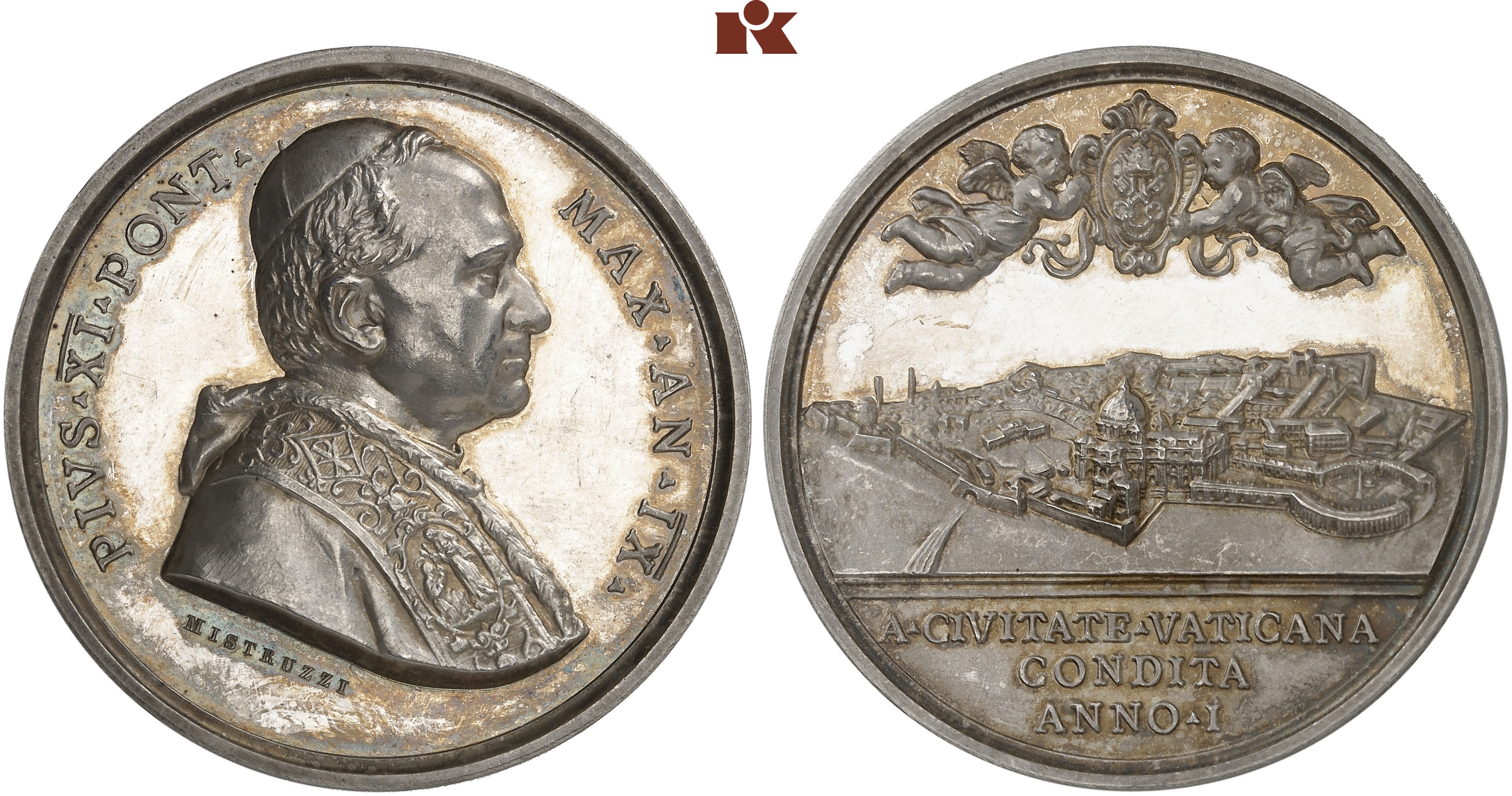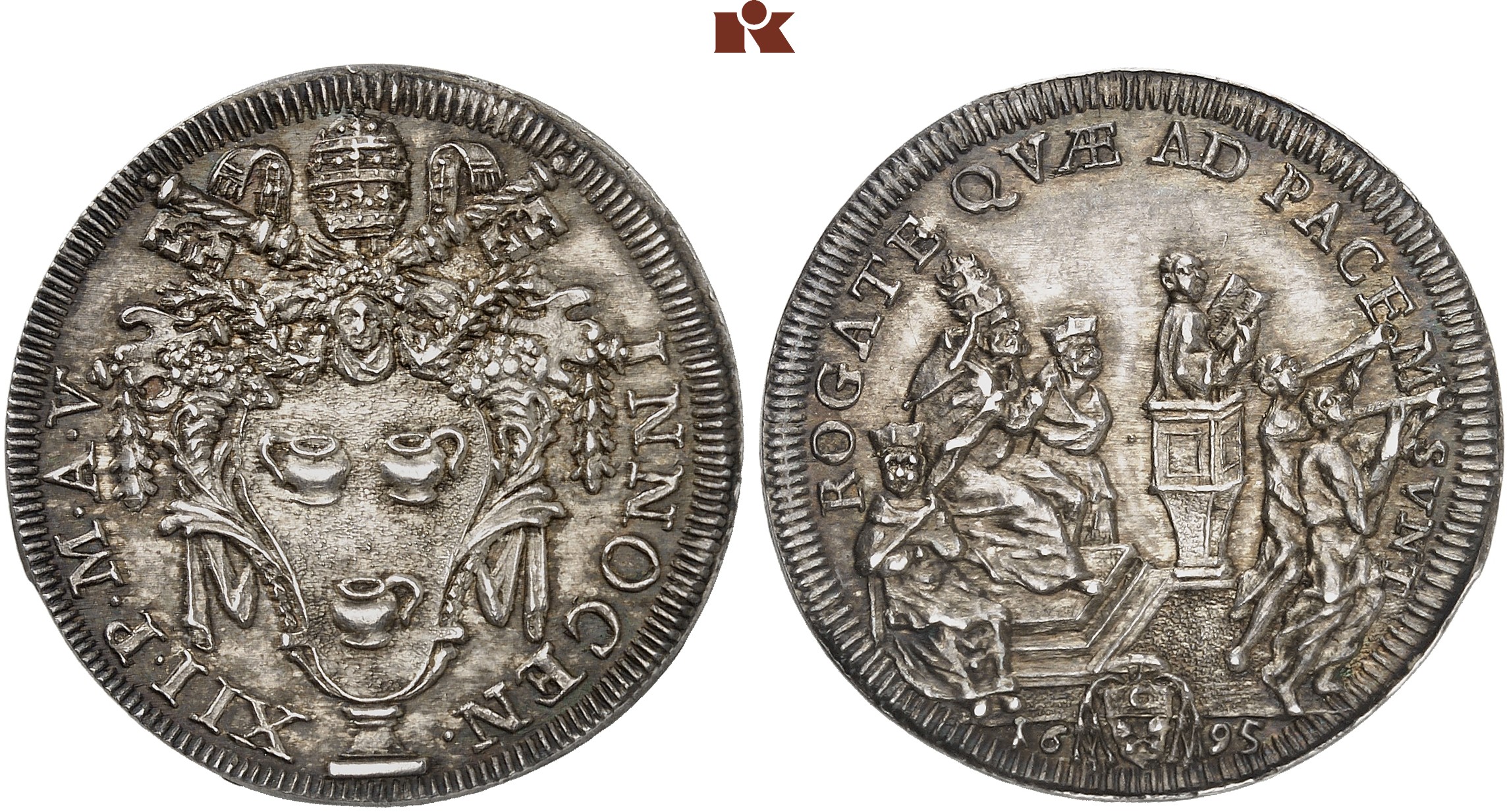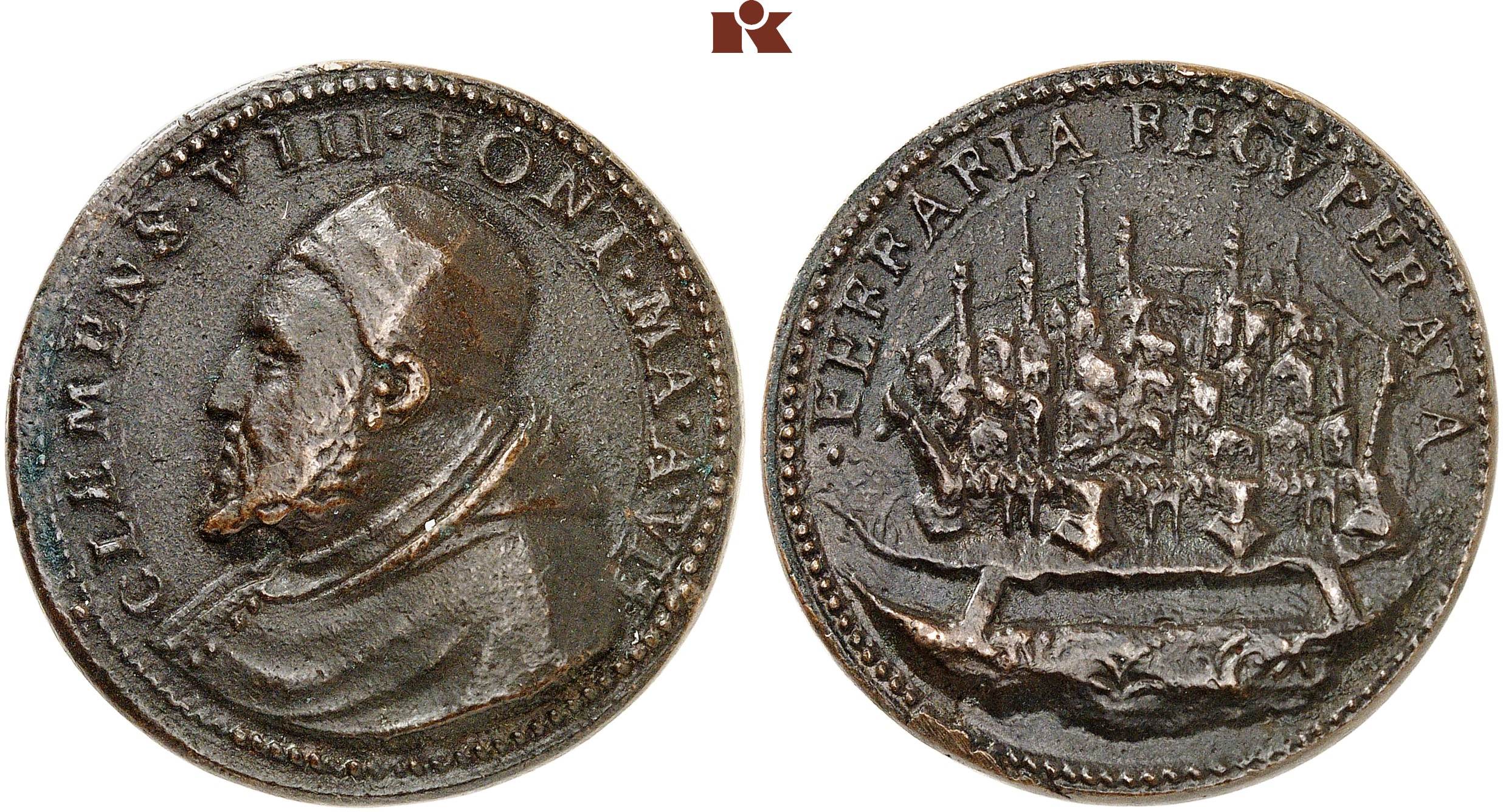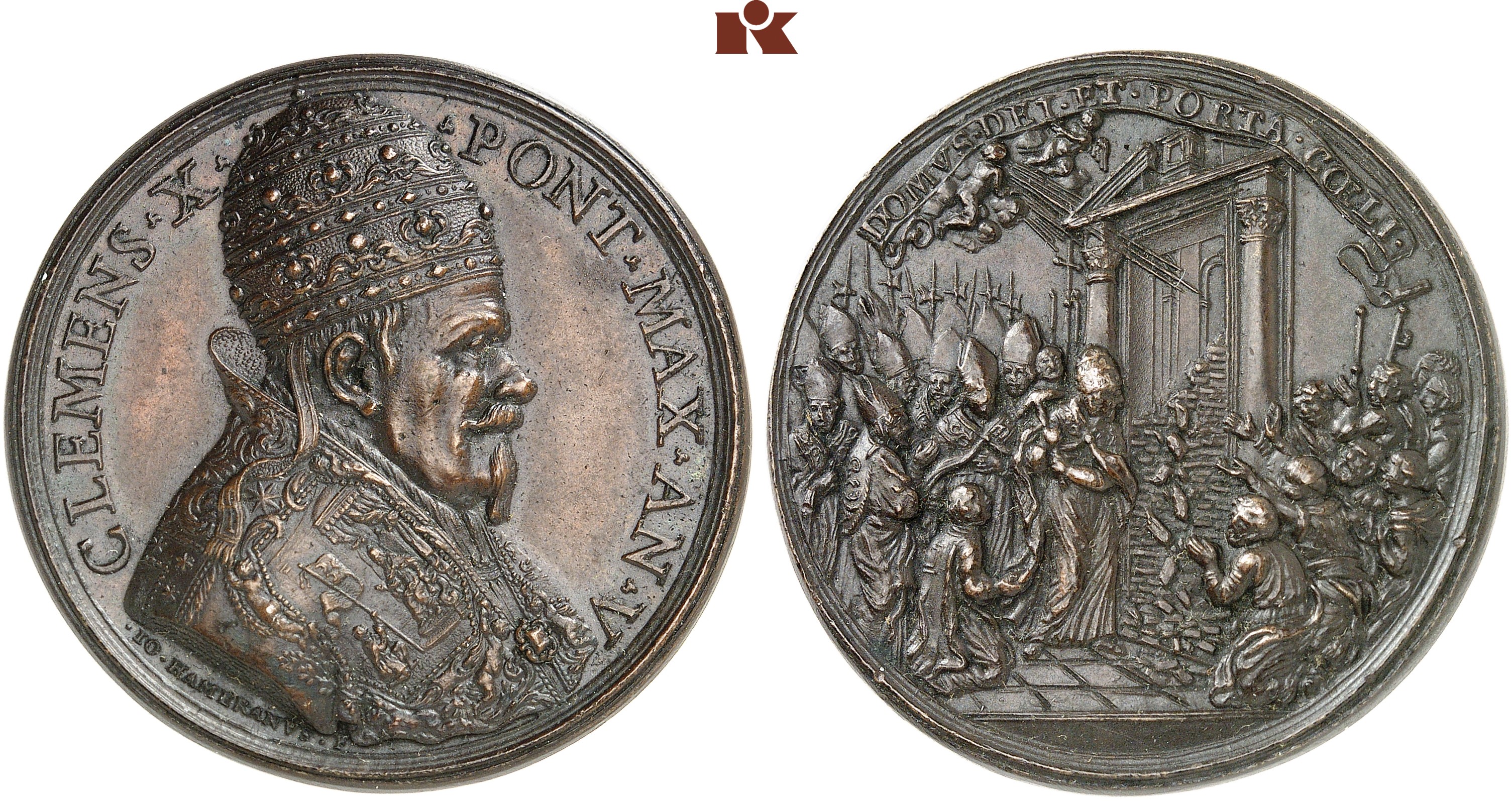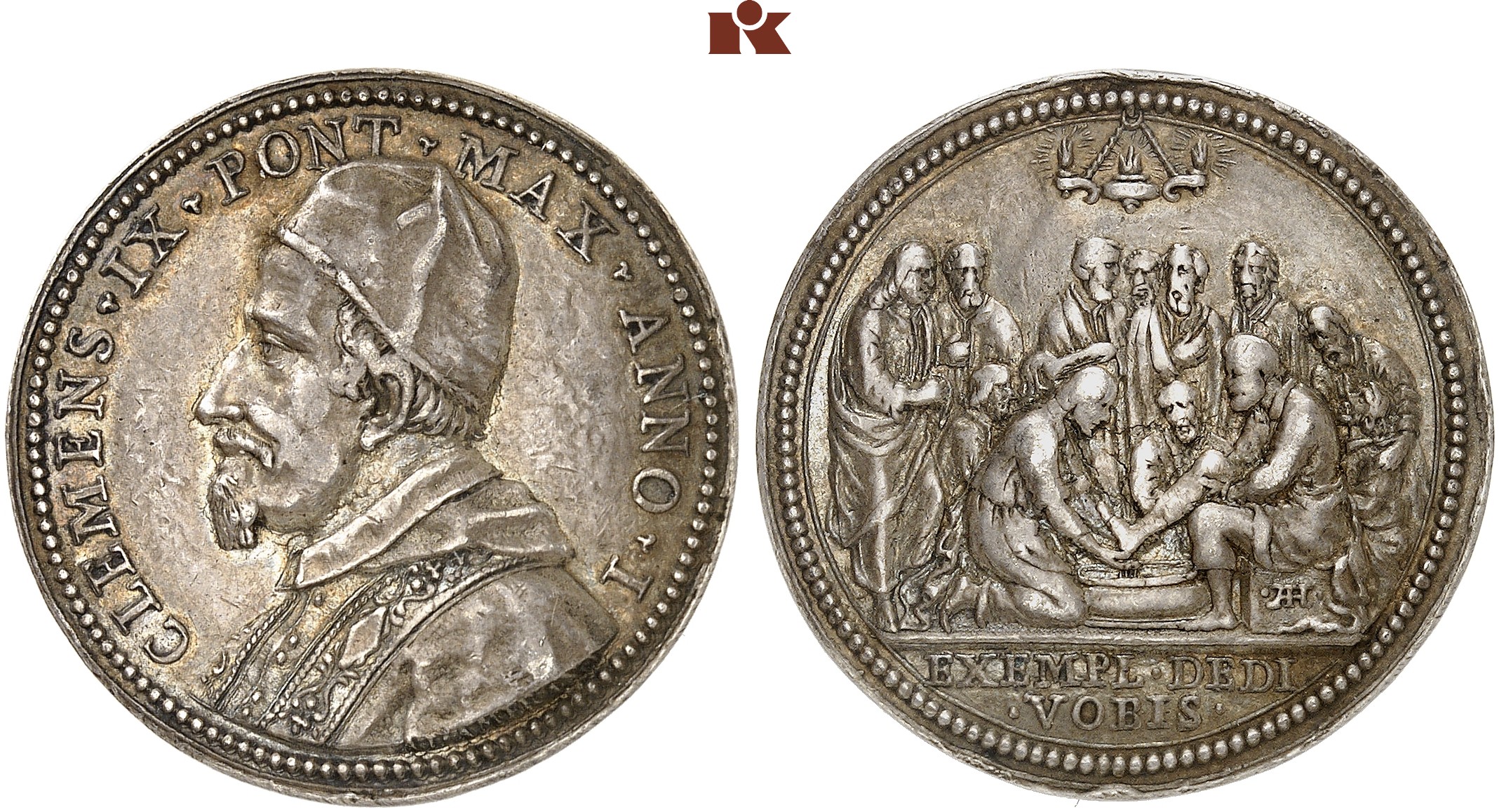Coins and Medals of the Popes: Representatives of the Catholic Church
22. Februar 2024 10:40
On 18 March 2024, the we will offer a special collection with coins and medals of the popes. Ever since the late 16th century, these issues probably served the main purpose of promoting the Catholic Church’s policies throughout the world on behalf of its supreme leader. The fact that these coins could also be used for payment purposes seems to have been overshadowed by their main objective. The manifold depictions inspired collectors to systematically build up ensembles of these pieces of high artistic value. So there is reason to argue that the numerous coins and medals of the popes were mainly issued for representative purposes and to be sold to collectors. This is a similar phenomenon to what we experience regarding Vatican euro coins today, as these pieces can also hardly ever be found in circulation.
Pius XI. 1930 medal by Aurelio Mistruzzi on the 1st anniversary of the foundation of the Vatican City State. Showpiece. Extremely fine to FDC / FDC. Estimate: 100 euros. From Künker auction 403 (18 March 2024), No. 1817
On 11 February 1929, the Holy See and the then Kingdom of Italy signed the Lateran Treaty, determining the status of Vatican City. This question had arisen following the demise of the Papal States in 1870. The Treaty stipulated that the state of Italy was to guarantee the Vatican’s political and territorial sovereignty. In return, the Holy See recognized that Rome could be the capital of Italy. Today, however, the Vatican only comprises a minor fraction of the territories that were under the pope’s rule in the mid-16th century.
The Papal States: Territorial Dominion and a Center of Early Tourism
In the mid-16th century, the power of the papacy was long past its zenith. The undisputed ruler over the souls of the faithful had become an Italian territorial prince like any other. However, the late 16th century saw new development arise: although Rome had lost its status as the center of Western politics, it evolved into a hotspot of early tourism and became the most important stop of any grand tour.
Grand tours were soon considered an indispensable part of the educational journey of any young nobleman throughout Europe. It did not serve the purpose of recreation. Instead, the young men learnt in a very practical way about the skills they needed to master to get one of the coveted administrative positions in the princely service. They wrote and conversed in Latin, Italian and French, learnt how to move in high society under the auspices of a companion, and fostered friendships as well as political alliances that would last for many years. Briefly said, having completed one’s grand tour was part of the identity of the European nobility.
Of course these aristocrats attached importance to bringing home physical evidence of their stay in the holy city. And since transporting such souvenirs was a costly matter, they preferred small objects – which brings us to the coins and medal issues of the popes.
Innocent XII. 1695 testone. Showpiece. Extremely fine to FDC. Estimate: 1,500 euros. From Künker auction 403 (18 March 2024), No. 1474
The testone depicts a scene that can often be seen on papal coins and medals: To the left is the pope, sitting on a cathedra in his regalia with tiara. To his right and left are two cardinals, which are easily recognizable due to their square caps, so-called birettas. In the right field are two musicians with trombones, heralding what happens next. In the center, we can see a man standing at the pulpit who is about to announce a papal bull. In this example of 1695, the document in question is the Ecclesiae Catholicae bull. It is expressly addressed at the Mainz cathedral chapter, which tried to use its power as an electoral body to establish itself as an institution of equal rights to the Mainz archbishopric. With his bull, the Pope prohibited future archbishops of Mainz from honoring agreements with the cathedral chapter without first submitting them to the Roman Curia for approval.
A Well-Devised Means of Papal Propaganda
Be it coins or medals – the carefully chosen depictions became excellent means for a pope to convey his religious, political and cultural objectives. Thanks to enthusiastic souvenir hunters, who flocked to Rome from all over the world, the papal messages on the issues spread throughout Europe.
Thus, the Vatican developed a well-devised numismatic program that was used by all popes. It did not only contain coins of various face values but also different types of medals. They were often linked to a particular event. For example, there are medals issued on the occasion of an election or a so-called possessio, the ceremony of the Washing of the Feet, a jubilee year or canonizations. We know of medals of merit and anniversary medals, and there are also many special medals such as pieces depicting architecture that were produced to have them integrated into the foundations of buildings.
Innocent XIII. 1721 medal by Ermenegildo Hamarani. Original strike. Extremely fine. Estimate: 300 euros. From Künker auction 403 (18 March 2024), No. 1543.
Medals such as this one were distributed by Pope Innocent XIII on the occasion of his possessio, an inaugural parade that took him from the Vatican to the Lateran. The reverse, however, does not show a procession but has to be understood as a comment on the policies he intended to implement: just like St. Michael, who is depicted on the medal, Innocent wants to drive out the devil – symbolized by the seven-headed dragon – to protect the Church just like the archangel did. The spirit of God, symbolized by the pigeon, rests on this work. The circumscription is taken from psalm 104. Its translation reads “You will renew the face of the earth”.
The Possessio Medal
Let us begin with the medal issued on the occasion of the possessio, a parade that played a crucial role in the official inauguration of every pope. This act was materialized through a magnificent procession. After due preparation, the newly elected pope would march from the Vatican to San Giovanni in Laterano on a white mule or a white horse at the head of all of his clergy. There he was greeted by a clerical delegation that handed him the keys to the church. The whole of Rome took part in these celebrations. Every social group had a role to play. Guilts and nations decorated the streets and neighborhoods they inhabited. The city council erected a triumphal arch. And all those who had no specific task to accomplish stood at the side of the road and cheered.
After the pope had taken up residence in the Lateran, he made a so-called presbyterian donation and distributed a gold and a silver medal each to every cardinal. The pieces required for this were kept by the supreme treasurer in a red and a white damask bag. During the ceremony, he took the pieces out for each of them, handed them to the cardinal deacon, who in turn handed them to the pope, who then dropped them graciously into the cardinal’s hands.
Of course, the cardinals were not the only ones to receive such medals. They were given to all bishops, important dignitaries, ambassadors, Roman noblemen, high-ranking pilgrims and many others. The ruling dynasties of Europe received their specimen from the nuncio, the papal ambassador. He personally handed over the precious piece in the audience in which he officially announced the possessio of the new pope.
Whoever could afford it kept these medals as a sign of papal favor. Depending on its value, the specimens were either placed in a coin collection or proudly worn on a gold chain. Some people even punched a few holes in their medals and sewed them onto a hat.
Those who were in need of the material value of the medal sold the precious piece. After all, there was high demand for them in Rome. A flourishing coin trade had established itself there. Those who had no personal connections to the Catholic Church and did not receive a medal during the celebrations could buy the coveted pieces – at least if they had enough money.
Clement VIII. Annual medal as bronze cast from the year of reign VII (=1598/99) by Giorgio Rancetti. Very fine. Estimate: 100 euros. From Künker auction 403 (18 March 2024), No. 1348.
In 1597, Clement VIII laid claim to Ferrara as a vacant fiefdom since Alfonso II d’Este had died childless in that very year. He seized Ferrara in 1598 and integrated it into the Papal States. The importance that Clement attached to this move is shown by the fact that he made it the subject of his annual medal.
The Annual Medal
29 June, the Feast of Saints Peter and Paul, was another date on which papal medals were distributed every year. This was not unusual in early modern times. Back then, every major prince, and every small nobleman engaged in a gift ceremony at least once a year and gave presents to everyone he felt somehow connected to. Coins and medals were particularly popular gifts. On this occasion, the pope used to issue three different versions of a medal –in gold, in silver and in bronze. The reverse sides highlighted the most important event of the last papal year.
Those who did not receive a papal medal could purchase the pieces from the papal engraver. After all, the latter was allowed to keep the dies he created and produce re-strikes as often as he wished. The dies were in his possession and he could bequeath and sell them. That explains the fact that there are many late re-strikes of papal medals.
Clement X Piastra 1675. About extremely fine. Estimate: 500 euros. From Künker auction 403 (18 March 2024), No. 1387
Clement X. Medal for the Holy Year of 1675 by Giovanni Martino Hamerani. Extremely fine. Estimate: 50 euros. From Künker auction 403 (18 March 2024), No. 1399.
Coins and medals with the depiction of the most important ceremony of the jubilee year were particularly popular with tourists. The coin presents the opened Holy Doors, which were usually walled up and were only used as a path to enter the church in a holy year. The doors promised a very special indulgence to those who passed through. Pilgrims flocked to Rome from everywhere to benefit from this indulgence. The medal shows the pope opening these very doors. Hamerani depicted him in full regalia with the ritual hammer. Behind him are the bishops; even further behind are the halberds of the Swiss Guards. In the right of the field we see pilgrims kneeling and cheering at the sight of the open doors.
The Coin Trade in Rome
This means that those who wanted to buy coins and medals to transport them across the Alps first went to Via del Pellegrino, where the gold smiths were located. If they considered a new re-strike to be too expensive, they could try Via dei Coronari, which is named after the rosaries offered there by traders in devotional objects. Needless to say, these merchants also sold medals. And then, of course, there were street vendors. You could get lucky and actually acquire a genuine piece from them, but it was much more common to buy a more or less well made cast of the kind that can also still be found in collections to this day.
In other words, it was best for laypeople to seek out expert advice. But not all those who called themselves an expert could be trusted. Too many Cicerones did excellent business by encouraging their clients to buy poor objects at expensive prices. Blessed were those who could rely on an experienced antiquarian as a coin dealer, like the great rulers of Europe did. People like Jacopo Strada, Fulvio Orsini or Francesco Gottifredi knew all the tricks of the shady street vendors. On behalf of their clients, they preferred to purchase entire collections and sell them to their clients for a good profit.
Clement IX. Medal for the Washing of the Feet by Alberto Hamerani 1667/68. Very fine to extremely fine. Estimate: 200 euros. From Künker auction 403 (18 March 2024), No. 1380
Medals for the Washing of the Feet or medaglia della lavanda, as they were called by the Papal Treasury, were distributed on Maundy Thursday. To this day, the Pope follows Jesus’ example and washes the feet of twelve selected men in an ecclesiastical ceremony. While these men originally received a gold coin as a present, Pope Leo X (1531-1521) was the first to have special medals produced for this purpose. These medals were issued until 1870.
London as a Center of the Trade in Papal Coins and Medals
What started in the mid-16th century became a wide-spread phenomenon in the late 18th century. The years after the end of the Seven Years’ War and before Napoleon’s campaigns are today regarded as the golden age of grand tours. English lords in particular travelled to Rome and bought anything they could get their hands on. Thus, London developed into a center of auctions offering papal coins and medals. In the 18th century, almost 100 of such sales took place in London. However, auction catalogs did not always distinguish between coins and medals. This is hardly surprising as inexperienced numismatists still struggle to differentiate between both categories today. The coins have beautiful reverse motifs and can be easily mistaken for medals, and were just as readily exported to Europe as souvenirs.
An Inexhaustible Source of Imagery
The papal production of coins and medals was of course stimulated by the demand of visitors to Rome. Those who produced the coins readily opted for depictions that were sure to appeal to tourists. Of course, the Catholic faith was at the center, but the abundance of buildings and scenes with crowds of people is striking. They must have been more popular with tourists! Here, too, many aspects remind us of modern phenomena of commemorative coinage, which focuses on the needs and wishes of collectors. Papal issues present the image of Rome that tourists would expect and wanted to show to their loved ones at home.
The catalog for Künker’s upcoming auction 403 provides you with an opportunity to immerse yourself in one of the oldest fields of numismatic interest. If you understand German and want to learn more about the historical background, we recommend “Die Silberne Stadt – Rom im Spiegel seiner Medaillen” of the State Coin Collection in Munich, published in 2021 by Hirmer Verlag and edited by Matteo Burioni and Martin Hirsch. We relied on this work regarding many details in this article. Another interesting read is the work “Glänzende Propaganda – Kirchengeschichte auf Papstmedaillen” by Kay Ehling and Jörg Ernesti, published in 2019 by the Herder Verlag.


